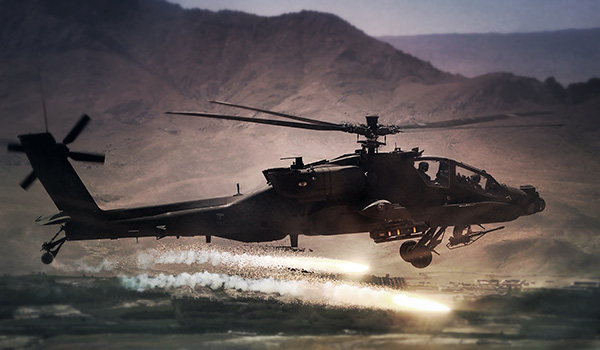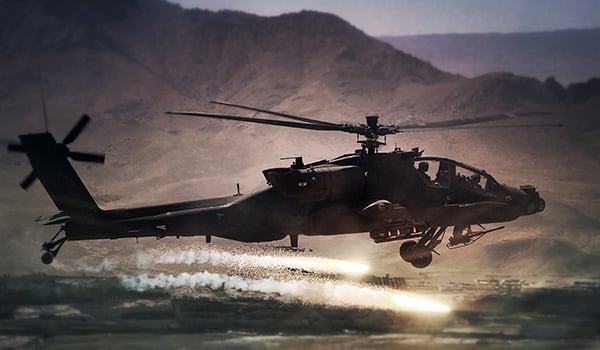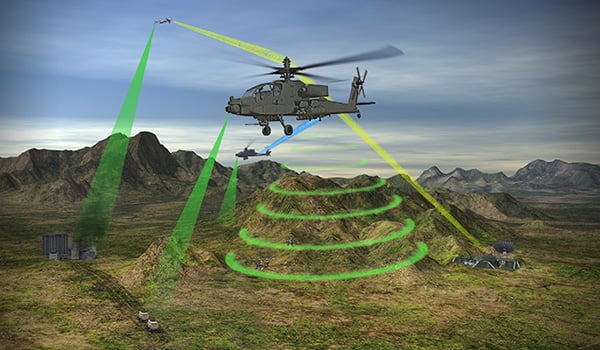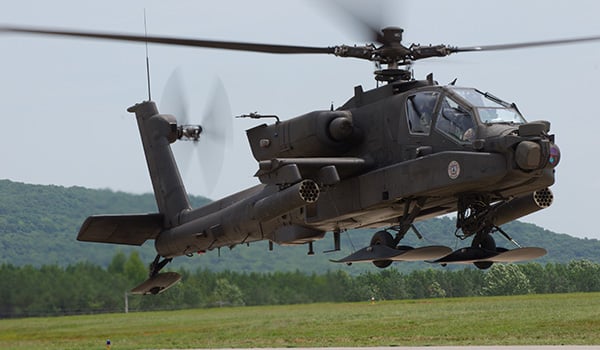
Rotary WIng / By COL Jeffrey E. Hager with COL (Ret.) Robin D. Cofer: The Army’s Aviation Restructure Initiative focuses the attack and scout roles on the AH-64 Apache, combined with Unmanned Aerial Systems. The Apache fleet is transitioning to one of the most technologically advanced weapon systems on the battlefield. The AH-64D Longbow Block I aircraft are completely out of Active Duty units and less than 100 exist in the Army Reserve, National Guard, and the training base at Fort Rucker. Block II Longbows will begin returning to the production facility in 2018. We begin fielding the 5th AH-64E unit in February 2016. As the older AH-64D Longbow Apaches are heading back to the production line, the newest AH-64E model is rolling out the other side.

1-229th Attack Reconnaissance Battalion deployed with the latest attack helicopter, the AH-64E. The E model Apache provides commanders and crews with greater capability, sustainability, and lethality on the battlefield./U.S. ARMY PHOTO BY CW3 JOSEPH WANKELMAN
Version 4 (V4) Technology Insertions
The first V4 AH-64E aircraft will come off the Apache Remanufacture Production line in January 2016, part of our Production Lot 5. The AH-64E V4 will provide an array of increased capabilities for our Soldiers. The modification will consist of a second Ethernet Routing Device (ERD), Enhanced Solid State Recording Device (eSSRD), Air-to-Air-to-Ground Video Relay (AAG), Blue Force Tracker 2 (BFT2), Link 16 Small Tactical Terminal, Reduced size Crashworthy External Fuel System (RCEFS), and Improved Fire Detection.
In the communications arena, the AH-64E will be the first regular Army rotary wing aircraft with Link 16 via the integration of the Small Tactical Terminal (STT) radio. The Small Tactical Terminal is a two channel software defined radio which weighs less than ten pounds. Software Version 4 integrates the first channel of the STT radio with Link 16. AH-64E software currently in development, Version 6, will include integration of the Soldier Radio Waveform (SRW) on the second channel of the STT radio.
Link 16 is a military tactical data exchange that provides a standardized communications link for the transmission of digital information. Link 16 is the Department of Defense’s primary data link providing a wide array of tactical information to include: command & control, situational awareness, targeting, precise participant location and identification (PPLI), and secure voice. This capability allows military aircraft, ships and ground forces to exchange their tactical picture in near-real time. Link 16 is used by all branches of the military as well as 30+ NATO and Coalition Nations.
SRW is a short range, line of sight, mobile ad-hoc networking waveform providing automatic network forming, merging and re-routing capabilities transparent to the user, facilitating transmission of information across large distances and elevated terrain. SRW is an IP-based waveform that provides local area connectivity for small combat units that supports networking between mounted and dismounted soldiers.
Several of the upgrades are aircraft enhancements, providing enhanced information assurance protocols onboard and improving internal computing power. For example, the ERDs enable the aircraft to meet Cyber requirements by providing protection and isolation of the Apache Mission Processor internal network and providing additional interconnectivity and robustness. Also, the eSSRD will provide increased throughput and capacity while mitigating obsolescence.

Manned-Unmanned Teaming Extended Capability (MUMT-X) provides the attack helicopter community greater situational awareness, real time battlefield video, and a common shared picture with troops on the ground. This capability increases an Apache crew’s coordination with other aircraft and Soldiers they support in battle. Apache is the first helicopter to utilize this technology./L-3 COMMUNICATIONS GRAPHIC
The AAG is part of our Manned-Unmanned Teaming system and allows the Apache to transmit Apache sensor video to ground and/or other airborne systems. RCEFS will consist of a new digital fuel panel, transfer pump, and connecting lines which will enable the use of ballistic tolerant 125 gallon external tanks. The fire detection modifications provide enhanced crew awareness through three additional sensors, a fire barrier, and a new Fire Detect Panel Assembly for “AFT FIRE.”
Our team, with support from Aviation Engineering Directorate, Yulista, and Boeing, completed a validation/verification effort in November 2015 for the V4 retrofit installation. This effort outlined the procedures for maintenance personnel to retrofit these new V4 enhancements on aircraft already delivered to units. The Production and Fielding Modifications Team will install the V4 retrofits at location of the AH-64E battalions already fielded and the Fort Rucker training base. The current plan is to conduct the modifications of two aircraft at a time to minimize readiness impacts. The retrofit modifications are currently planned to begin in early 2017. The Apache Remanufacture Production Line will continue delivering V4 capable aircraft until the FY19 (Lot 9) timeframe when the transition to V6 capability occurs.
Manned/Unmanned Teaming Expanded Capability (MUMT-X)
Manned-unmanned (MUM) teaming is the use of video feeds and weapons from manned platforms such as an Apache and unmanned platforms (commonly referred to as UAVs or UAS) to provide significantly improved situational awareness to troops on the ground and dramatically improve efficiency in focusing weapons to support ground elements. While the concept of MUM teaming emerged over 10 years ago, the tactics, techniques, and technologies required to maximize benefit to our Soldiers continue to evolve and mature.

For the first time, AH-64s have been fielded in Alaska in 2015. As part of the Aviation Restructure Initiative, 1-25th Attack Reconnaissance Battalion moved from Fort Carson, CO to Fort Wainwright, AK. Part of their unit specific requirements for their extreme conditions included another first for US Apaches – skis. The skis were tested by the Redstone Test Center and Aviation Engineering Directorate released a unit specific Air Worthiness Release./U.S. ARMY PM APACHE COURTESY PHOTO
 Apache was the first Army Aviation platform with a formal requirement for MUM teaming. Two early MUM teaming systems were developed, initially for the AH-64E and later for the AH-64D as a result of the Operational Needs Statement (ONS). Both systems provided unique capabilities and increased pilot situational awareness, but neither system met the full set of user requirements. It was also expensive to train and sustain multiple platforms. Based on lessons learned, emerging user requirements, and Aviation Restructure Initiative (ARI) requirements, the Army directed the Apache Project Office to provide an expanded set of MUM capabilities through a program called MUMT-X.
Apache was the first Army Aviation platform with a formal requirement for MUM teaming. Two early MUM teaming systems were developed, initially for the AH-64E and later for the AH-64D as a result of the Operational Needs Statement (ONS). Both systems provided unique capabilities and increased pilot situational awareness, but neither system met the full set of user requirements. It was also expensive to train and sustain multiple platforms. Based on lessons learned, emerging user requirements, and Aviation Restructure Initiative (ARI) requirements, the Army directed the Apache Project Office to provide an expanded set of MUM capabilities through a program called MUMT-X.
MUMT-X is required to provide Level of Interoperability (LOI) 2-4 which will allow Apache pilots to control UAS payload and flight path, significantly increasing pilots’ situational awareness and safety. In addition to LOI 2-4, requirements include multi-band, increased modem processing power to reduce operator workload, Voice Over Internet Protocol (VOIP), increased information assurance/cybersecurity, additional waveform capability, exportability for FMS (objective), and additional encryption while meeting affordability goals.
MUMT-X is currently planned to be installed on the AH-64E and the Project Office will ensure the system can be quickly retrofit to the field.
The Army is considering expanding the MUMT-X Basis of Issue Plan (BOIP) from nine (9) systems per battalion to 15, ensuring that all AH-64E battalions will either be Fire Control Radar (FCR) or MUMT-X capable above the rotor. We are also working to ensure compatibility between the Modernized Radar Frequency Interferometer (M-RFI) and MUMT-X, in addition to FCR compatibility.
The MUMT-X System will have initial prototypes delivered in Summer 2016. MUMT-X will be integrated into the AH-64E Version 6 configuration and operationally tested during the Follow-on Test and Evaluation (FOTE) II in October 2017. Mass production of MUMT-X to support the Apache production line are planned for 2018. We will retrofit to previously fielded AH-64Es beginning in the 2018-2019 timeframe.
Conclusion
The Apache program is moving forward to meet all of the capability requirements identified by the Army. Fielding Version 4 capabilities this year gets us one step closer to the desired endstate. Version 6 capabilities are currently being developed and we are excited about the future of this aircraft.
Attack!
COL Jeffrey E. Hager is the project manager for the Apache Project Office, Program Executive Office for Aviation, Redstone Arsenal, AL; COL (Ret.) Robin D. Cofer is a support contractor with S3 Inc., Huntsville, AL supporting the Apache Project Office.
























